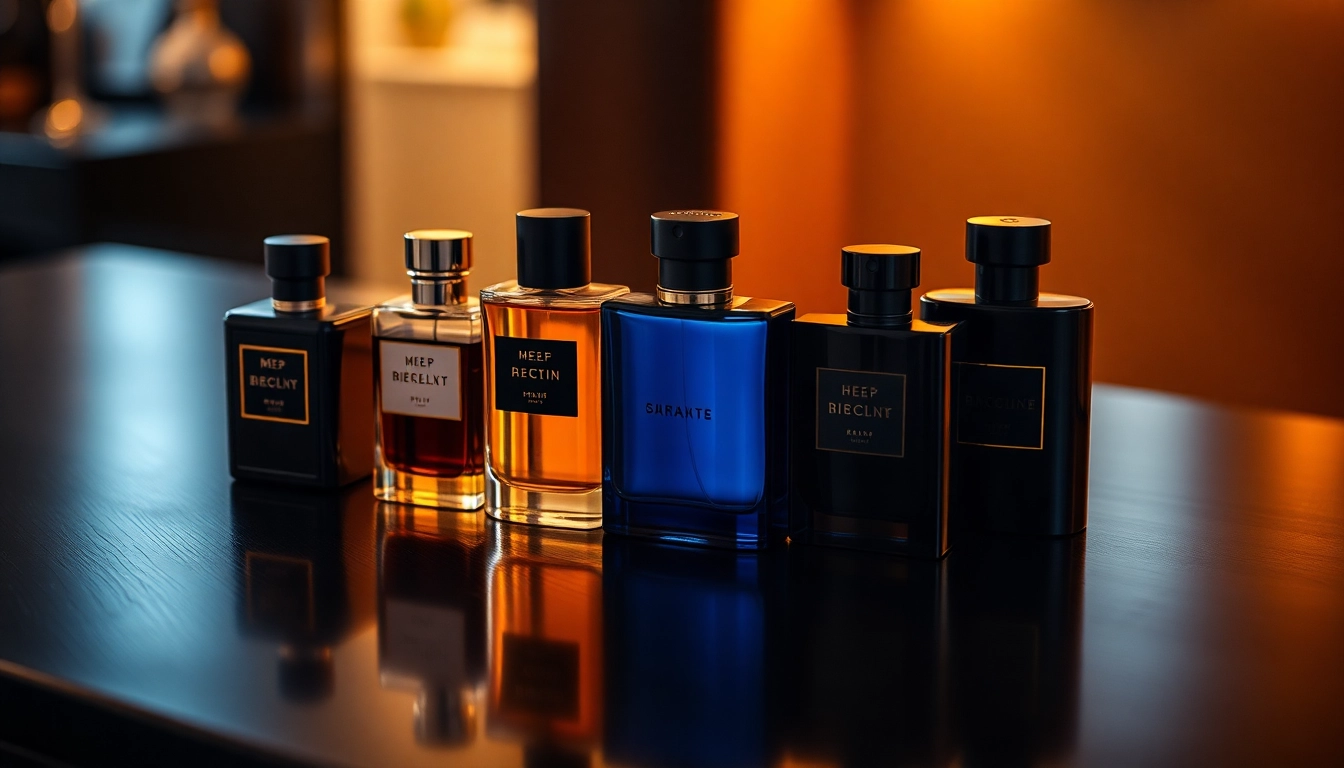Understanding Men’s Fragrances
What Defines Men’s Fragrance?
Men’s fragrance is not just about adding a pleasant scent; it’s an expression of personality, mood, and style. Typically categorized under the broader umbrella of perfumery, men’s fragrances encompass a wide range of scents tailored specifically for men. These fragrances are often constructed with male consumers in mind, showcasing notes that resonate with traditional masculine qualities such as strength, confidence, and elegance. The essence of a fragrance is determined by its composition—the balancing act of top, middle, and base notes that together create a memorable olfactory experience.
Popular Notes and Scents in Men’s Fragrances
When exploring the world of men’s fragrance, one will quickly encounter a diverse palette of scents. These are often grouped into categories like woodsy, aromatic, citrus, and spicy, each evoking different emotions and providing distinct experiences.
- Citrus: Fresh and invigorating, notes like lemon, bergamot, and grapefruit offer a clean scent that is perfect for daytime wear.
- Aromatic: This category often includes herbs and spices such as basil, lavender, and rosemary. Aromatic fragrances are versatile and can transition well from day to night.
- Woody: Notes like cedar, sandalwood, and vetiver are frequently found in men’s fragrances, projecting a sense of warmth and robustness.
- Oriental: Rich and complex, oriental fragrances include spices, resins, and sweet notes like vanilla, making them suitable for evening wear.
- Floral: Although often associated with women, select floral notes like jasmine and rose have started to appear in men’s fragrances, providing a modern twist.
Choosing the Right Fragrance Type
Understanding the different types of fragrances available is crucial when selecting the right scent. The concentration of fragrance oil in a product determines its longevity and intensity. The main categories include:
- Perfume (Extrait de Parfum): The most concentrated form, with a fragrance oil concentration of 20-30%. It lasts the longest, often for more than 8 hours.
- EDP (Eau de Parfum): Slightly less concentrated at 15-20%, EDPs are still robust and typically last 4 to 8 hours.
- EDT (Eau de Toilette): With a concentration of 5-15%, EDTs are lighter, ideal for daytime and casual wear, offering a lifespan of around 3 to 5 hours.
- EDC (Eau de Cologne): Lightest in concentration, often at 2-5%. EDCs are refreshing but short-lived, perfect for a quick spritz.
Identifying Your Signature Scent
Factors to Consider When Selecting a Fragrance
Finding a signature scent is a personal journey that involves understanding your lifestyle, preferences, and skin chemistry. Consider the following:
- Occasions: Are you looking for a scent for everyday wear, special occasions, or both?
- Personal Style: Your fragrance should complement your wardrobe and reflect your personality.
- Skin Type: Different skins carry scents differently. Oily skin can hold fragrances longer than dry skin, influencing your choice.
Test and Trial: The Importance of Sampling
Sampling fragrances is an essential step in the selection process. Testing a scent on your skin rather than just on a tester strip allows you to gauge how it interacts with your body chemistry. It’s advisable to apply a small amount to your wrist, letting it settle for at least an hour before making a decision. Additionally, note that the fragrance will evolve, showcasing different notes over time as it dries.
Seasonal Preferences in Fragrance Selection
Your fragrance choices can also be influenced by seasonal changes. Lighter, fresher scents are preferable in the warmer months, while heavier, more intense fragrances are often favored in cooler months. Consider the following:
- Spring: Opt for fresh citrus or green scents that evoke the rejuvenation of nature.
- Summer: Light, aquatic, and fruity notes can keep you feeling refreshed in the heat.
- Autumn: Woody or spicy scents resonate with the warm hues of fall and the comfort of being indoors.
- Winter: Warm, rich, and deep fragrances, such as those with amber, vanilla, or leather notes, can provide a cozy feeling.
How to Apply Fragrance Like a Pro
Best Practices for Applying Men’s Fragrance
Applying fragrance correctly can significantly enhance the wear time and overall experience. Here are some best practices:
- Pulse Points: Apply fragrance to pulse points—areas like the wrists, neck, and behind the ears that radiate heat and help develop the scent.
- Distance: Spray the fragrance from about 6-8 inches away to achieve optimal coverage without overwhelming yourself or others.
- Layering: If you wish to create a more complex scent, consider layering your fragrance with complementary scented products like aftershave or body lotion.
Layering Scents: A Guide to Blending Fragrances
Layering scents can create a personalized signature that sets you apart. Start by selecting a base fragrance, then complement it with another scent that has complementary notes. For example, a woody fragrance can be beautifully layered with a subtle floral or fresh note. Be cautious not to overpower; ensure that the scents harmonize rather than clash.
The Role of Skin Chemistry in Fragrance Longevity
Understanding your skin chemistry is integral to how a fragrance develops and lasts. Factors such as pH level, diet, and skin moisture can all influence how a scent performs. People with oilier skin may find that fragrances last longer, as oil can help maintain scent. In contrast, dry skin may require a more concentrated fragrance or additional layering to prolong wear.
Men’s Fragrance Trends to Watch
Emerging Fragrance Ingredients and Brands
As the fragrance industry evolves, new trends emerge that reshape consumer preferences. Today, there is a growing focus on unique ingredients that were once considered unconventional. Brands are increasingly experimenting with notes like:
- Green Tea: Known for its fresh and energizing scent, green tea is becoming popular for its cleansing and revitalizing properties.
- Ginger and Cardamom: Spices like ginger and cardamom provide warmth and intrigue, perfect for those who appreciate a spicy edge.
- Terpene-rich Ingredients: Ingredients such as cannabis or certain herbs are making their way into perfumery, appealing to the olfactory senses in a new way.
Eco-Friendly and Vegan Fragrance Options
In response to soaring environmental consciousness, more brands are offering eco-friendly and vegan fragrances. These options often utilize sustainable sourcing and natural ingredients, appealing to consumers who prioritize ethical purchasing. Frequent consumers are encouraged to explore brands that put sustainability front and center, ensuring their choices reflect their values.
Luxury vs. Affordable: Navigating the Market
The fragrance market is vast, presenting a wide array of options across different price ranges. Luxury fragrances are often crafted with the finest ingredients and come in elegant packaging, making them appealing as gifts or indulgent treats. However, there are also many affordable fragrances that offer excellent quality, broadening accessibility. Choosing between these options ultimately depends on individual preferences, budget, and occasion.
Caring for Your Fragrance Collection
Storage Tips to Preserve Fragrance Quality
Proper storage of your fragrance collection is essential for maintaining their quality and longevity. To ensure resilience:
- Keep Them Cool and Dark: Store fragrances away from heat sources and direct sunlight to prevent them from deteriorating.
- Avoid Humidity: Bathrooms can be too humid; consider a climate-controlled environment that’s dry.
- Use Dark Glass Bottles: Many fragrances come in dark-colored bottles for a reason—to protect them from light.
Identifying Expiration and Deterioration Signs
Fragrances can change over time, potentially affecting their scent and performance. Here are signs to watch for:
- Color Change: A noticeable darkening or alteration in color can indicate that a fragrance has aged poorly.
- Scent Alteration: If the fragrance smells sour or differs significantly from its original scent, it may be time to retire it.
- Separation: Any visible separation of components can signal degradation.
Refreshing Older Fragrances: When to Say Goodbye
Not all fragrances are meant to last a lifetime. Understanding when to part ways with an older fragrance can help keep your collection fresh. A good rule of thumb is to evaluate longevity based on how often you wear the fragrance. If it has not been used in a while or is exhibiting signs of deterioration, consider replacing it with something new. Trust your nose; if the scent no longer appeals to you, it’s time for a change.


